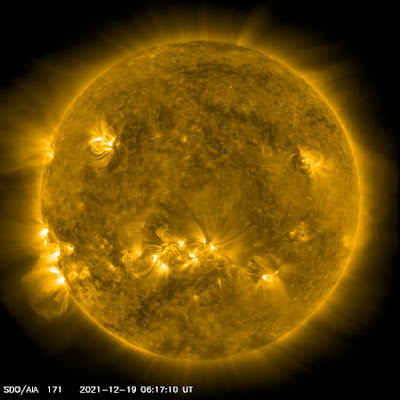 LHS Episode #445: Year-End Round Table 445
LHS Episode #445: Year-End Round Table 445
Hello and welcome to Episode 445 of Linux in the Ham Shack. In this final episode of 2021, we invite listeners to join us via Discord for a discussion of amateur radio, technology, open source software and hardware and the year in review. We even depart briefly into hedonism as well. We hope you enjoy this community-driven content, have a safe and happy holiday season and join us again when we re-start the show on January 6, 2022.
73 de The LHS Crew
Russ Woodman, K5TUX, co-hosts the Linux in the Ham Shack podcast which is available for download in both MP3 and OGG audio format. Contact him at russ@bluecows.com.
 RAC Winter contest.
RAC Winter contest.
The RAC Winter contest is in the books and my second contest where I was running and not S&P. The propagation numbers took a big leap in the right direction before and during the contest. I did find that even with the good conditions there was steep QSB on 20 and 40m.
I find this more of a relaxed contest compared to the international contests. Most of the time, CW speeds were a bit slower. When someone you know makes contact, there is time to say thanks and 73. Speaking of someone you know, I had the pleasure of John AE5X a blogger I follow contact me, and we had the opportunity to send pleasantries to each other. Thanks for the contact John.
I found there was the early contest jitters, but I did settle in a bit sooner compared to the other contest. One take away was to NEVER try drinking coffee while calling CQ! Thought I had this calling CQ thing down, I decided to have a drink of coffee as the PC was belting out RAC DE VE9KK. While in mid-sip of coffee, the radio went to receive and a nice multiplier station was coming back to me! In a rush to put the coffee down my elbow was banged, coffee all over the keyboard and multi station gone!
Overall, a great time was had.
Mike Weir, VE9KK, is a regular contributor to AmateurRadio.com and writes from New Brunswick, Canada. Contact him at ve9kk@hotmail.com.
 RAC Winter contest.
RAC Winter contest.
The RAC Winter contest is in the books and my second contest where I was running and not S&P. The propagation numbers took a big leap in the right direction before and during the contest. I did find that even with the good conditions there was steep QSB on 20 and 40m.
I find this more of a relaxed contest compared to the international contests. Most of the time, CW speeds were a bit slower. When someone you know makes contact, there is time to say thanks and 73. Speaking of someone you know, I had the pleasure of John AE5X a blogger I follow contact me, and we had the opportunity to send pleasantries to each other. Thanks for the contact John.
I found there was the early contest jitters, but I did settle in a bit sooner compared to the other contest. One take away was to NEVER try drinking coffee while calling CQ! Thought I had this calling CQ thing down, I decided to have a drink of coffee as the PC was belting out RAC DE VE9KK. While in mid-sip of coffee, the radio went to receive and a nice multiplier station was coming back to me! In a rush to put the coffee down my elbow was banged, coffee all over the keyboard and multi station gone!
Overall, a great time was had.
Mike Weir, VE9KK, is a regular contributor to AmateurRadio.com and writes from New Brunswick, Canada. Contact him at ve9kk@hotmail.com.
 ICQ Podcast Episode 366 – Seasonal Radio Fun
ICQ Podcast Episode 366 – Seasonal Radio Fun
In this episode, Martin Butler (M1MRB) is joined by Chris Howard (M0TCH), Martin Rothwell (M0SGL) and Frank Howell (K4FMH) to discuss the latest Amateur / Ham Radio news. Colin (M6BOY) rounds up the news in brief and in the episode's feature Seasonal Radio Fun.
We would like to thank David Bowie (ZL4DRB) and our monthly and annual subscription donors for keeping the podcast advert free. To donate, please visit - http://www.icqpodcast.com/donate
- Storm Arwen - Why Power Cuts Left People Unable to Phone for Help
- World’s Smallest Moon Lander will Put Ham Radio Transmitter on the Moon
- Senator Blumenthal Supports Amateur Radio at Senate Confirmation Hearing
- 60th Anniversary of Launch of First Ham Radio Satellite
- RSGB National Radio Centre to Close Temporarily
- First GI-QRP Convention
- Monaco Special Event
Colin Butler, M6BOY, is the host of the ICQ Podcast, a weekly radio show about Amateur Radio. Contact him at info@icqpodcast.com.
 Cycle 25 … On The Move?
Cycle 25 … On The Move?
Anyone looking at the Sun this week has to be impressed with its sudden reawakening over the past few days. From its recent somewhat troubling slumber, with flux numbers in the high 70s, these values have quickly risen to a Cycle 25 high in the 120s as of early Saturday. With at least two more active regions about to rotate into view shortly, it seems as though these numbers might continue to grow.
What is interesting is the suddenness with which these groups formed as this is a keystone marker for the long awaited ‘terminator’ event … the point at which cycle growth starts to increase rapidly. Is this it or will the Sun go back to sleep as it has in the past few excursions into the 90’s?
If this rapid increase does indeed herald the terminator's arrival, it’s a sign that Cycle 25 should be one of above average strength. Wouldn’t that be nice after Cycle 24’s weak showing over the past 11 years.
With the present asymmetry of the Sun's two hemisphere, we are guaranteed a cycle with a double hump in the peak years. The first peak is usually the strongest but not always. Let's see how Cycle 25 plays out in this department.
I’ve yet to do any comparisons with past progress of strong cycles at this same point into their upward climb but let’s cross our fingers and hope the present numbers continue for some time. There will always be drops of course but if recovery is quick, we may still be in for a good ride in Cycle 25.
Steve McDonald, VE7SL, is a regular contributor to AmateurRadio.com and writes from British Columbia, Canada. Contact him at ve7sl@shaw.ca.
 Top Five K0NR Blog Posts for 2021
Top Five K0NR Blog Posts for 2021
Closing out 2021, here are the top five blog posts at k0nr.com during the year. Some people may see this as a lazy way of creating one more blog post for the year without much work. This is definitely true. I hope you enjoy it anyway.
Leading the list is this blog post…a perennial favorite that seems to make the top five each year:
This is another popular article that explains some of the details behind the 2-meter band plan. This particular article is tuned for Colorado but it also provides a link to an article that covers the topic for the USA.
New this year, is the post about the North America Adventure Frequency, which was promoted by the ARRL Contest Update newsletter:
This post is my attempt at humor concerning the SOTA obsession of small transceivers:
Once again, coming in at fifth place is one of my personal favorites that talks about proper kerchunking of repeaters. It even introduced a new Q-signal for kerchunking, although I must admit it may not be catching on.
Editors Choice
Just for good measure, I am including one more post that I think is notable. I wrote this one after looking around the web for a good explanation of what is a valid QSO? I never did find a good, up-to-date definition of a QSO, so I wrote one. This one may turn out to be an evergreen article but so far it has not gotten a lot of hits.
Merry Christmas and Happy New Year!
73 Bob K0NR
The post Top Five K0NR Blog Posts for 2021 appeared first on The KØNR Radio Site.
Bob Witte, KØNR, is a regular contributor to AmateurRadio.com and writes from Colorado, USA. Contact him at bob@k0nr.com.
 AmateurLogic 163: Cheapmunks Christmas
AmateurLogic 163: Cheapmunks Christmas
AmateurLogic.TV Episode 163 is now available for download.
Tommy completes the LiFePO4 battery build and begins load testing. Emile runs Multi-applications on his shack Pi. The Cheapmunks drop by for a high frequency Christmas. Canadian and Creole holiday Food tasting.
George Thomas, W5JDX, is co-host of AmateurLogic.TV, an original amateur radio video program hosted by George Thomas (W5JDX), Tommy Martin (N5ZNO), Peter Berrett (VK3PB), and Emile Diodene (KE5QKR). Contact him at george@amateurlogic.tv.


















